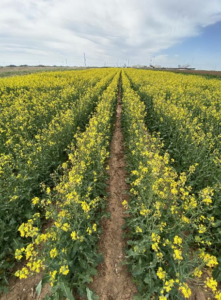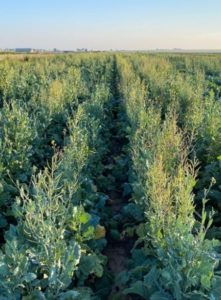Jourdan M. Bell, Carla Naylor, and Juan Piñeiro
Canola is largely produced as an oilseed crop, but it is also a high-quality forage (grazing and ensilage), although as with other forages, nutritive value is closely tied to the agronomic management, crop maturity and growing conditions. In the Texas High Plains, corn has traditionally been the silage of choice, but as irrigation capacities decline, livestock producers are evaluating alternative forage options including canola. While there is limited canola planted for oilseed production, in recent years canola silage (canolage) has continued to expand in the western Texas High Plains as an alternative forage option for dairies. In response to increased canola forage acres, Texas A&M AgriLife personnel have received questions surrounding the ideal maturity for harvest.
In 2020, canola forage yield and nutritive value were evaluated for one cultivar (Griffin) at the Texas A&M AgriLife James Bush Research Farm at Bushland, Texas on drip irrigation. Griffin is a winter hardy, dual-purpose (forage and seed) KSU variety that is adapted to the southern High Plains. Although previous canola planting date studies at Bushland identified September as an ideal seeding period for oilseed production, a late winter planting date was also evaluated in 2021 as a forage option. Canola was planted on September 24, 2020, and February 1, 2021, on 30-inch rows at 500,000 seeds per acre. Total irrigation was 5.6 inches for the September planting and 3.0 inches for the February planting. Forage was harvested at flowering and the early ripening stages (Image 1).
| Image 1. From left to right: September 2020 planted canola at flowering, September 2020 planted canola at early ripening, and February 2021 planted canola at early ripening. |
Canola forage yields increased with plant maturity. Yields were greatest for the early ripening growth stage when pods were still green and most flowers had dropped, but there was a decline in evaluated forage nutritive value (Table 1). Crude protein (CP) decreased 6% from the September 2020 planted forage at flowering to early ripening stage. The acid detergent fiber (ADF) and Neutral Detergent Fiber (aNDF) increased as plants matured. The ADF is a measure of the plant cellulose, lignin, and insoluble protein. The aNDF is a measurement of the fiber. Lower ADF and aNDF are indicative of improved digestibility and forage quality. The relative feed value (RFV) is an index combining NDF and ADF as a forage benchmark relative to alfalfa at full bloom assuming 41% ADF and 53% aNDF. Indices of NEL (net energy for lactation) and RFV suggested improved forage nutritive value for harvest at flowering. The RFV for the fall planted canola at the flowering stage was 226 indicating a forage that would be classified as prime. Although RFV decreased 52% from flowering to early ripening, the RFV remained greater than 100. The forage nutritive value for the September 2020 and February 2021 planting dates at early ripening were comparable.
Table 1. Forage yield and specific nutritive value parameters for evaluated planting dates and harvest stages (GS=growth stage). Means followed by the same letter do not significantly differ using LSD (0.05). CP=Crude Protein, ADF=Acid Detergent Fiber, aNDF=Neutral Detergent Fiber measured with amylase, TDN=Total Digestible Nutrients, NEL=Net Energy for Lactation, RFV=Relative Feed Value
High moisture contents at harvest require canola to be swathed and wilted before ensiling. Ensiling allows producers to preserve high moisture forages and maintain forage quality, but moisture contents greater than 70% increase the leachate or liquid seepage from the silage pile. In addition to leachate concerns, high moisture forages do not reach ideal lactic acid concentrations, and fermentation is often not stabilized resulting in poor fermentation and risking the development of clostridial organisms. When cutting high moisture forages, producers should consider environmental conditions, potential forage shrink, and he desired forage quality including intake and nutritive value. Research at Washington State demonstrated that blending canola forage with a lower dry matter (DM) feed source could minimize leachate loss. Canola forage may not be a stand-alone forage; it is a high-nutritive value option that should be blended with other feed sources because it can have very low fiber and high protein. Canola can also be high in nitrates. While nitrates dissipate during the ensiling process, producers should always test the forage prior to feeding. Fresh canola can also be chopped and fed immediately as greenchopped forage rather than ensiled. Data from 2021 demonstrated that September and February planting dates could provide producers planting flexibility when growing canola as a forage in the Texas High Plains.
Additional Resources:
Harner, J., J.P. Murphy, W. Boyer, J. Davidson, H. George, R. Graber, S. Minson, and M. Harvey. 2020. Leachate from Silage and Wet Feed Storage. Kansas State University Agricultural Experiment Station and Cooperative Extension Service. MF3542 https://bookstore.ksre.ksu.edu/pubs/MF3542.pdf
Kung, L., R.D. Shaver, R.J. Grant, and R.J. Schmidt. 2018. Silage review: Interpretation of chemical, microbial, and organoleptic components of silages. J. Dairy Sci. 101(5): 4020-4033.
https://doi.org/10.3168/jds.2017-13909
Neely, C.B., J. Brown, C. W. Hunt, and J. B. Davis. 2009. Increasing the value of winter canola crops by developing ensiling systems (canolage) to produce cattle feed. (13) (PDF) Increasing the value of winter canola crops by developing ensiling systems (canolage) to produce cattle feed (researchgate.net)



